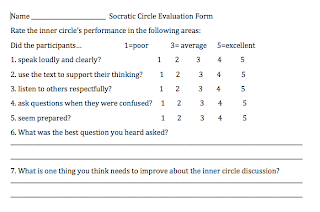A couple blog posts ago I talked
about Socratic circles, and I gave them a shot this week. On the whole, it was a great
experience, and I’m looking forward to trying them again. But of course, there
are things that I will modify for next time, and I thought it might be useful
to reflect on what I liked and what I would change.
To start with, the kids need to be
discussing a text they are somewhat familiar with, and we used Robert Frost’s poem
“The Road Not Taken,” which I had assigned as their fluency reading for the
week. Theoretically, all of them had read it at least five times, and I had
asked them to underline words they didn’t know, and to write down three
questions they could ask, so we had some questions ready to go. This was a good
idea, and I think I would do something like this again, until we get better at
generating questions more easily. The poem was challenging for fourth graders, and I am fine with that,
although I don’t think anyone loved it just because it is quite a bit more
difficult than other, more kid-friendly poems they’ve read. But they do need to grapple with
challenging text, and this gave them that opportunity.
I had thought a bit about how to
divide the kids into two groups, and when I saw how many kids had brought back
their homework (not many), that solved the problem for me. I sorted the
returned homework into two stacks, making sure that each group had some strong
students in it (hoping that they would be leaders, and they were), and then I
put all the other kids without homework into the groups, assuming they would
sit next to someone with the text.
The inner circle sat on the floor,
and I had the outer circle sit around them on chairs with clipboards for their
response sheet. (See a copy of the outer circle response sheet below.) That
worked out well, but all groups said they had difficulty hearing the students
speaking, so by the last group I used our class microphone, which slowed the
conversation down a bit but did make it much easier to hear.
I felt that all groups really
worked to do their roles. The outer circles concentrated on what people were
saying, and how they were saying it, and the inner circles tried to ask and
respond to questions. I think that was the hardest part, as many students
wanted to ask their questions but weren’t always interested in thinking about
other people’s questions. I’m hoping that changes as we get better at the
discussion part. Many in the outer
circle commented that all students did not participate, and I think that is a
more powerful observation when it comes from one’s peers. It will be
interesting to see if there is more participation the next time we try this. I
know there are some very quiet students, and this is pushing them out of their
comfort zone, so I need to do more thinking about how to encourage them to contribute.
Finally, my last observation would
be that you need time to do this. The first group I allotted about thirty
minutes, and this wasn’t quite enough for the first experience with the
activity. The second group always has a shorter class time anyway, and we ended
up breaking our discussion time into two days. That worked better only because both groups had more time
without feeling rushed, but I liked having both groups go on the same day to
keep the discussion more fluid.
Allotting forty-five minutes would have been the smart thing, which I’ll
keep in mind for the next time.
Perhaps the best indicator of the
success of my first Socratic circles would be the student responses. I had a
number of students ask if we were going to do them again, and I was happy to
tell them we would. I highly recommend you give Socratic circles a try!
